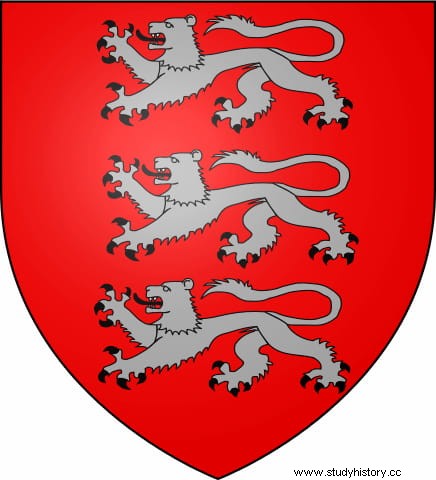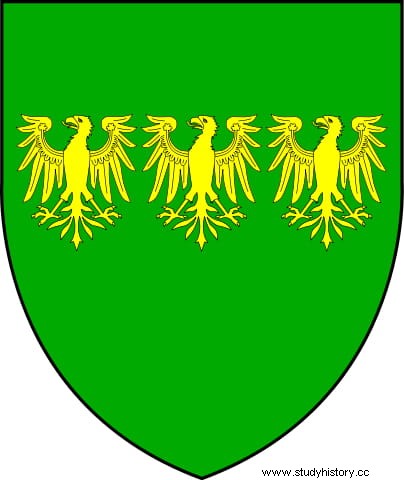Although examples are not lacking -and some very famous-, in general women have not been lavished in war history because, traditionally, the trade of arms has been exercised by men. For this reason, the cases in which the so-called weaker sex have starred in battles or led armies usually attract attention. One of the most significant, and yet least known, was that of the Welsh Gwenllian ferch Gruffydd, in the middle of the Middle Ages.

We said that there are a few female names linked to combat actions. Some of them are very familiar to us because they took place in Spain or their carriers are Spanish, from María Pita to Agustina de Aragón, passing through Inés de Suárez or Catalina de Erauso. But they all date from after the 16th century and that is why Jimena Blázquez, María Pérez de Villanañe or Juana García de Arintero would be better examples, who girded swords in medieval times, just as the Breton corsair Juana de Belleville, the Japanese Tomoe Gozen or the most famous of all, Joan of Arc.
There were also cases in Great Britain, although there the focus is mainly on the resistance of Queen Boudicca against the Roman occupation or the story of Petronila de Grandmesnil, captured after following her husband -wearing armor and all- in the rebellion against King Henry II. Just a few decades before the latter episode, Gwenllian ferch Gruffydd's epic response to prevent the Norman invasion of Wales took place, something unique in the annals of that nation.
The name of this heroine should not be taken literally because in Welsh it means Gwenllian daughter of Gruffydd. That is to say, she was a princess, since Gruffudd ap Cynan was the sovereign of Gwynedd, one of the six small kingdoms into which the current country of Wales was divided during the Middle Ages. Founded in the 5th century by a predynastic monarch, Cunedda, after the departure of the Romans from Britain, was the land of the Venedotia, a name that brought together Celtic tribes such as the Ordovicians, Gangani and Deceanglos, expanding over the following centuries to cover the entire north of Wales, including the island of Anglesey.

The Irish Sea made up most of Gwynedd's border except for the southern half, where it abutted the kingdom of Powys. This made it reasonably protected against external danger, since the sea on one side and the mountains on the other acted as natural defenses, which did not prevent foreign interference from sometimes deposing the kings, often taking advantage of internal discord. In the year 1066, the Normans, who had just conquered England, also occupied Gwynedd in one of those turbulent periods.
Bleddyn ap Cynfyn then reigned to the detriment of his half-brother Gruffydd, who was the rightful heir. Little by little, this one was gaining followers from the exile of him and appropriating more and more territory until forcing Bleddyn to retire to Powys, where he also wore the crown. Gruffydd thus recovered the throne from him but ephemerally, since the death of his ally, Ælfgar of Mercia, and the betrayal of some of his own made him end up assassinated. He was replaced by Earl Harold Godwinson, who has gone down in history as Harold II of England.
Harold was defeated by the Norman William the Conqueror , who, unstoppable, not only took over English territory but also set his sights on the Welsh. The Norman nobles divided up the kingdom and it seemed that a long stage was beginning with their presence there, but in 1094 there was a general insurrection and in 1136 they were crushingly defeated by Owain Gwynedd, who launched a victorious reconquest campaign until his death. in 1170.
Then the civil war broke out over the succession. But let's stop in the narrative to look at the family of the deceased. He was the eldest son of Gruffydd ap Cynan and Angharad, and therefore the brother of Cadwallon, Gwynedd and Cadwaladr, who were the ones who positioned themselves in two opposing blocks for inheritance. They had five sisters:Mared, Rhiannell, Susanna, Annest, and the youngest, Gwenllian, who is of interest to us here. He was born in the year 1100 in Aberffraw, a town on the southwest coast of Ynys Mon (present-day Anglesey), which was then the capital of the kingdom of the Kingdom of Gwynedd from the year 860 and also gave its name to the House of those characters. 
As they say, Gwenllian was of a proverbial beauty and that is why she dazzled Gruffydd ap Rhys, prince of the neighboring southern kingdom of Deheubarth, who in the year 1113 was visiting Gwynedd, since his father had been an ally of the girl's father. As expected, both fell in love and after a brief courtship they married (note that she was not more than thirteen years old). Together they settled in Dinefwr and had four sons:Morgan, Maelgwyn, Maredudd, and Rhys Fychan; the first three died young, twenty, seventeen and twenty-five years old; only the third had a long life.
Gruffydd recruited an army to attack the Norman castles in his occupied kingdom of Deheubarth, where settlers had settled not only from Normandy but also from England - which was under Norman rule, remember - and Flanders. Lacking a territorial point of reference, the rebel troops moved from one place to another and this included the royal family, with Gwenllian following her husband wherever she went, taking advantage of the cover provided by mountains and forests. /p>
In such conditions, they opted for a guerrilla tactic of surprise attacks and rapid retreats that made it very difficult for the Normans to defend themselves, since their strong point was to entrench themselves in the impregnable castles scattered throughout the kingdom. In addition, the rebels not only had the support of the House of Aberffraw but also that of the House of Dinefwr, the one plundered by the Normans because it was the one that ruled Deheubarth before (by the way, the Tudors are descended from Dinefwr).
In 1136 the aforementioned great insurrection took place, taking advantage of the fact that England was plunged into chaos due to the succession to the English throne. It all started when Stephen of Blois, Duke of Normandy, overthrew his cousin Matilde and came to the throne, but not before a period of civil war that has gone down in history with the graphic name of Anarchy, which lasted from 1135 to 1153. This affected the governability of Wales, whose local leaders were deprived of central authority, thus inciting the people to revolt.

This began in the south with the campaign of Hywel ap Maredudd, Lord of Brycheiniog (Brecknockshire), against the Normans of Gower (a southern mark of Deheubarth), whom he defeated at the Battle of Llwchwr, near Swansea, by surprising them with an entire army instead of the poorly armed bands they expected. Half a thousand Norman soldiers perished in the clash and the victory resounded throughout Wales, encouraging others to take up arms as well. The first, Gruffydd ap Rhys and his wife Gwenllian, who joined forces with those of her father and among all of them multiplied sympathizers when it became known that their princes distributed among the Welsh the lands and goods seized from the hated invaders.
The Normans reorganized themselves and launched counterattacks to try to put down the rebellion and help their leader, Maurice, who began to gather them at Cydweli Castle, in the current town of Kidwelly, where he had taken refuge fleeing from Llwchwr. Aware of the danger and in the absence of her husband, who was with her father in the north, Gwenllian led a small force and laid siege to the castle. They would be around two hundred men, insufficient for the plan conceived by her:use half of them to cut the supply line and the rest to stop the reinforcements that arrived to meet with Maurice.

Still, it seems that what went wrong was an imponderable:a traitor. None other than one of the tribal chiefs, named Gruffydd ap Llewellyn. Thus, it was the Normans who surprised the Welsh and not the other way around, and Maurice himself allowed himself to leave the protection of his battlements to participate in the slaughter. Gwenllian was knocked off her horse and beheaded right there, losing her two eldest sons in the process, which we previously reviewed:her firstborn, Morgan, died trying to defend her and the other, Maelgwyn, was captured and executed. .
The scene of that tragic clash is known today as Gwenllian Maes (Gwenllian Field) and in it there is a spring that, according to legend, flows right where she lost her life. It is not trivial because the death of Gwenllian inflamed the spirits of all Wales and it was then that the aforementioned insurrection became general, putting the entire country on a war footing. In that sense, Gruffydd ap Rhys had the opportunity to avenge the death of his family and also helped by his father-in-law, since both won a crushing victory over the enemy at Crug Mawr, near Cardigan, thus controlling the entire western region of Ceredigion.

Perhaps it was they who started a long-standing tradition of Welsh soldiers:that of shouting “Revenge for Gwenllian!” going into battle. Of course, these were very propitious times for the creation of epic myths; it is not uncommon for Gwenllian to be depicted in art riding a chariot and blowing her long red hair in the wind. Actually, in the Middle Ages she was no longer fought like this but she was seen as if she were a reincarnation of Boudicca.
Gruffydd, Gwenllian's father, died the following year and that was when her sons Owain and Cadwaladr abandoned the campaign against the Normans to start a civil war to succeed her father; but the work of this, considered in his last years a kind of golden age, allowed that, despite everything, the kingdom of Gwynedd remained safe. In the end there was a compromise solution:Owain ascended the throne leaving his brother Anglesey and Ceredigion, although later they would face each other again.
As for Gruffydd ap Rhys, the widower of Gwenllian, he also died in 1137, although under what circumstances is unknown. His heir was Anarawd, an offspring he had had from a previous marriage (four in total, with another named Cadell and three girls, Gwladus, Elizabeth and Nest) since he was older than the survivor of those with Gwenllian, Rhys. However, he would also reign later; and he honored his mother by baptizing two of her daughters Gwenllian.
